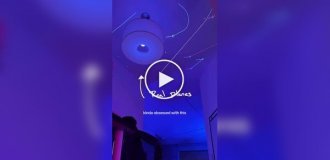From the history of school uniforms (7 photos)
Back in 1834, the same uniform was approved for all civilian uniforms in the empire. In general, school uniforms have a long history. How I disliked those blue scoop pants. Now the kids have better options, I think. So, educational!

This system included gymnasium and student uniforms. And in 1896, a regulation on gymnasium uniforms for girls appeared. Pupils of the famous Smolny Institute were required to wear dresses of certain colors, depending on the age of the pupils. For pupils 6 - 9 years old - brown (coffee), 9 - 12 years old - blue, 12 - 15 years old - gray and 15 - 18 years old - white.
Until 1917, the uniform was a class sign, because Only children of wealthy parents could afford to attend a gymnasium. The uniform was worn not only within the walls of the educational institution, but also on the street, at home, and during celebrations. Boys wore military-style uniforms, and girls wore dark, formal dresses with pleated knee-length skirts.
However, soon after the revolution, as part of the fight against bourgeois remnants and the legacy of the tsarist police regime, a decree was issued in 1918 abolishing the wearing of school uniforms. Undoubtedly, in the early years of the Soviet state, wearing a school uniform was an unaffordable luxury in a country devastated by world war, revolution and civil war.

School uniforms became mandatory again only after the Great Patriotic War in 1949, a unified school uniform was introduced in the USSR. From now on, boys were required to wear military tunics with a stand-up collar, and girls were required to wear brown woolen dresses with a black apron.
The dresses were modestly decorated with lace collars and cuffs. Wearing a collar and cuffs was mandatory. In addition to this, girls could wear black or brown (everyday) or white (ceremonial) bows. Bows of other colors were not allowed according to the rules. It is worth noting that in general, the school uniform for girls of the Stalin era was similar to the school uniform of Tsarist Russia.
The strict morals of the Stalin era extended, of course, to school life. The most minor experiments with the length or other parameters of the school uniform were severely punished by the administration of the educational institution.
Even the hairstyle had to meet the requirements of Puritan morality - “model haircuts” were strictly prohibited until the end of the 50s, not to mention hair coloring. Girls always wore braids with bows.
The school uniform of the era of I.V. Stalin can be seen in the films “First-Grader”, “Alyosha Ptitsyn Develops Character” and “Vasyok Trubachev and His Comrades”
In addition, after the war, separate education was introduced, which, however, was abandoned a few years later.

In 1970, in the charter of the secondary school, the school uniform existed as compulsory.
The “warming” of the regime did not immediately affect the democratization of school uniforms, however, it still happened.
The cut of the uniform became more identical to the fashion trends that took place in the 1960s. True, only the boys were lucky. For boys, from the mid-1970s, gray woolen trousers and jackets were replaced by trousers and jackets made of blue wool blend fabric. The cut of the jackets was reminiscent of classic denim jackets (the so-called “denim fashion” was gaining momentum in the world).
On the side of the sleeve was a soft plastic emblem with a drawing of an open textbook and a rising sun.
We can see schoolchildren of the late 1960s in the cult film “We'll Live Until Monday.”
In the early 1980s, uniforms for high school students were introduced. (This uniform began to be worn in the eighth grade). Girls from first to seventh grade wore a brown dress, as in the previous period. Only it was not much higher than the knees.
For boys, trousers and a jacket were replaced with a trouser suit. The color of the fabric was still blue. The emblem on the sleeve was also blue.

Very often the emblem was cut off because it did not look very aesthetically pleasing, especially after some time - the paint on the plastic began to wear off.
For girls, a blue three-piece suit was introduced in 1984, consisting of an A-line skirt with pleats at the front, a jacket with patch pockets and a vest. The skirt could be worn with either a jacket or a vest, or the whole suit at once. In 1988, the wearing of blue trousers in winter was allowed for Leningrad, regions of Siberia and the Far North.
In some union republics, the style of the school uniform was slightly different, as was the color. Thus, in Ukraine, school uniforms were brown, although blue ones were not prohibited.
It was this uniform for girls that contributed to the fact that they began to realize their attractiveness early. A pleated skirt, a vest and, most importantly, blouses with which you could experiment, turned almost any schoolgirl into a “young lady.”
A mandatory addition to the school uniform, depending on the age of the student, was the October (in primary school), Pioneer (in middle school) or Komsomol (in high school) badges. Pioneers were also required to wear a pioneer tie.
In addition to the regular pioneer badge, there was a special option for pioneers actively involved in social work. It was a little larger than usual and had the inscription “For active work” on it.
School uniforms from the 1980s can be seen, for example, in the films “Guest from the Future” and “The Adventures of Electronics”

Years pass and in 1991 school uniforms still exist. Gradually, the school uniform underwent changes and became a little looser.
The school uniform was abolished only in 1992 by a decision of the Russian Government, with the introduction of a new Law on Education.
Today, the issue of wearing a school uniform is resolved at the level of educational institutions, administrators and parents. There are no official documents, orders, instructions regarding the mandatory school uniform.
However, more and more educational institutions are turning to past experience and introducing school uniforms as a mandatory attribute of school life.

School uniforms in other countries are different from ours: in some places they are more conservative, and in others they are very fashionable and unusual. For example, in Japan, schoolgirls wear sailor suits, called “sailor fuku” there. Their uniform is the standard of teenage fashion for the whole world. Even outside of school, Japanese girls wear something that reminds them of their usual school uniform.
In Cuba, uniforms are mandatory for all students in schools and higher education institutions.
In Great Britain, school uniforms are as conservative as possible and are close to the classic style of clothing. Each prestigious school has its own logo, so students are required to come to classes with a “branded” tie.
In France, a single school uniform existed from 1927 to 1968. In Poland - until 1988.
Germany does not have a uniform school uniform, although there is debate about introducing one. In some schools, students can participate in the design of school clothes. Characteristically, even during the Third Reich, schoolchildren did not have a uniform uniform.
In the USA, each school decides for itself what items students are allowed to wear. As a rule, tops that reveal the midriff, as well as low-fitting trousers, are prohibited in schools. Jeans, wide trousers with many pockets, T-shirts with graphics - this is what students in American schools prefer.
In most European countries there is also no uniform form; everything is limited to a fairly strict style. In many countries of the world, the question of school uniforms, like ours, remains open.
School uniforms have opponents and supporters. Modern teenage schoolchildren, for the most part, are strongly opposed. Parents and teachers, on the contrary, advocate the introduction of this element, hoping that the school uniform:
disciplines students (business style obliges students to be strict and collected)
smooths out social differences between students,
helps keep distance between students and teacher.
allows you to track “strangers” at school
does not allow teenagers to dress provocatively.






















